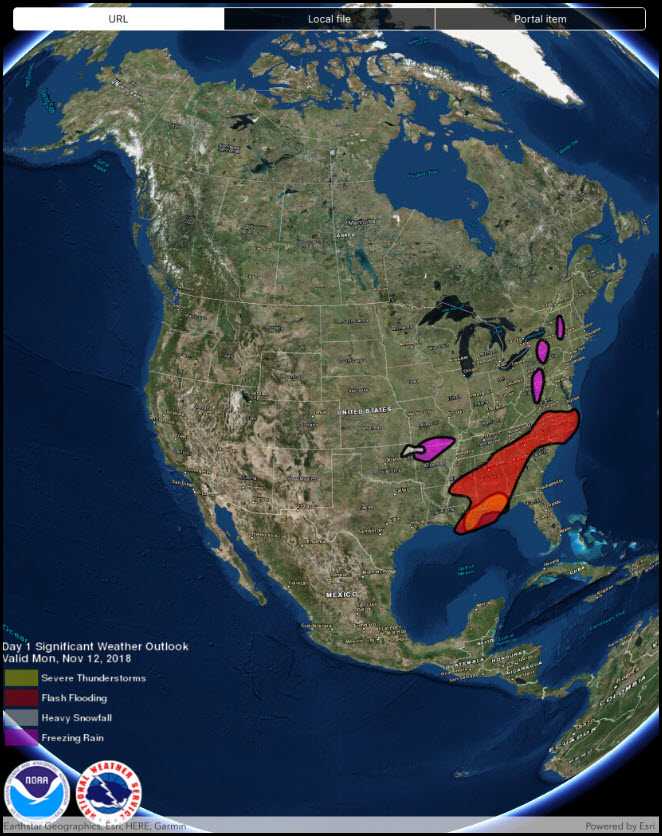Display KML from a URL, portal item, or local KML file.

Use case
Keyhole Markup Language (KML) is a data format used by Google Earth. KML is popular as a transmission format for consumer use and for sharing geographic data between apps. You can use Runtime to display KML files, with full support for a variety of features, including network links, 3D models, screen overlays, and tours.
How to use the sample
Use the UI to select a source. A KML file from that source will be loaded and displayed in the scene.
How it works
- To create a KML layer from a URL, create a
KmlDatasetusing the URL to the KML file. Then pass the dataset to theKmlLayerconstructor. - To create a KML layer from a portal item, construct a
PortalItemwith aPortaland the KML portal item ID. Pass the portal item to theKmlLayerconstructor. - To create a KML layer from a local file, create a
KmlDatasetusing the absolute file path to the local KML file. Then pass the dataset to theKmlLayerconstructor. - Add the layer as an operational layer to the scene with
scene.OperationalLayers.Add(kmlLayer).
Relevant API
- KmlDataset
- KmlLayer
Offline data
This sample uses US state capitals KML file. It is downloaded from ArcGIS Online automatically.
About the data
This sample displays three different KML files:
- From URL - this is a map of the significant weather outlook produced by NOAA/NWS. It uses KML network links to always show the latest data.
- From local file - this is a map of U.S. state capitals. It doesn't define an icon, so the default pushpin is used for the points.
- From portal item - this is a map of U.S. states.
Tags
keyhole, KML, KMZ, OGC
Sample Code
// Copyright 2018 Esri.
//
// Licensed under the Apache License, Version 2.0 (the "License"); you may not use this file except in compliance with the License.
// You may obtain a copy of the License at: http://www.apache.org/licenses/LICENSE-2.0
//
// Unless required by applicable law or agreed to in writing, software distributed under the License is distributed on an
// "AS IS" BASIS, WITHOUT WARRANTIES OR CONDITIONS OF ANY KIND, either express or implied. See the License for the specific
// language governing permissions and limitations under the License.
using System;
using ArcGISRuntime;
using ArcGISRuntime.Samples.Managers;
using Esri.ArcGISRuntime.Geometry;
using Esri.ArcGISRuntime.Mapping;
using Esri.ArcGISRuntime.Portal;
using Esri.ArcGISRuntime.UI.Controls;
using Foundation;
using UIKit;
namespace ArcGISRuntimeXamarin.Samples.DisplayKml
{
[Register("DisplayKml")]
[ArcGISRuntime.Samples.Shared.Attributes.Sample(
name: "Display KML",
category: "Layers",
description: "Display KML from a URL, portal item, or local KML file.",
instructions: "Use the UI to select a source. A KML file from that source will be loaded and displayed in the scene.",
tags: new[] { "KML", "KMZ", "OGC", "keyhole" })]
[ArcGISRuntime.Samples.Shared.Attributes.OfflineData("324e4742820e46cfbe5029ff2c32cb1f")]
public class DisplayKml : UIViewController
{
// Hold references to UI controls.
private SceneView _mySceneView;
private UISegmentedControl _dataChoiceButton;
private readonly Envelope _usEnvelope = new Envelope(-144.619561355187, 18.0328662832097, -66.0903762761083, 67.6390975806745, SpatialReferences.Wgs84);
private readonly string[] _sources = {"URL", "Local file", "Portal item"};
public DisplayKml()
{
Title = "Display KML";
}
private void Initialize()
{
// Set up the basemap.
_mySceneView.Scene = new Scene(BasemapStyle.ArcGISImagery);
}
private async void DataChoiceButtonOnValueChanged(object sender, EventArgs e)
{
// Clear existing layers.
_mySceneView.Scene.OperationalLayers.Clear();
// Get the name of the selected layer.
string name = _sources[((UISegmentedControl) sender).SelectedSegment];
try
{
// Create the layer using the chosen constructor.
KmlLayer layer;
switch (name)
{
case "URL":
default:
layer = new KmlLayer(new Uri("https://www.wpc.ncep.noaa.gov/kml/noaa_chart/WPC_Day1_SigWx.kml"));
break;
case "Local file":
string filePath = DataManager.GetDataFolder("324e4742820e46cfbe5029ff2c32cb1f", "US_State_Capitals.kml");
layer = new KmlLayer(new Uri(filePath));
break;
case "Portal item":
ArcGISPortal portal = await ArcGISPortal.CreateAsync();
PortalItem item = await PortalItem.CreateAsync(portal, "9fe0b1bfdcd64c83bd77ea0452c76253");
layer = new KmlLayer(item);
break;
}
// Add the selected layer to the map.
_mySceneView.Scene.OperationalLayers.Add(layer);
// Zoom to the extent of the United States.
await _mySceneView.SetViewpointAsync(new Viewpoint(_usEnvelope));
}
catch (Exception ex)
{
new UIAlertView("Error", ex.ToString(), (IUIAlertViewDelegate) null, "OK", null).Show();
}
}
public override void ViewDidLoad()
{
base.ViewDidLoad();
Initialize();
}
public override void LoadView()
{
// Create the views.
View = new UIView() { BackgroundColor = ApplicationTheme.BackgroundColor };
_mySceneView = new SceneView();
_mySceneView.TranslatesAutoresizingMaskIntoConstraints = false;
_dataChoiceButton = new UISegmentedControl(_sources)
{
BackgroundColor = ApplicationTheme.BackgroundColor,
TranslatesAutoresizingMaskIntoConstraints = false
};
// Clean up borders of segmented control - avoid corner pixels.
_dataChoiceButton.ClipsToBounds = true;
_dataChoiceButton.Layer.CornerRadius = 5;
// Add the views.
View.AddSubviews(_mySceneView, _dataChoiceButton);
// Lay out the views.
NSLayoutConstraint.ActivateConstraints(new[]
{
_mySceneView.TopAnchor.ConstraintEqualTo(View.SafeAreaLayoutGuide.TopAnchor),
_mySceneView.LeadingAnchor.ConstraintEqualTo(View.LeadingAnchor),
_mySceneView.TrailingAnchor.ConstraintEqualTo(View.TrailingAnchor),
_mySceneView.BottomAnchor.ConstraintEqualTo(View.BottomAnchor),
_dataChoiceButton.LeadingAnchor.ConstraintEqualTo(View.LayoutMarginsGuide.LeadingAnchor),
_dataChoiceButton.TrailingAnchor.ConstraintEqualTo(View.LayoutMarginsGuide.TrailingAnchor),
_dataChoiceButton.TopAnchor.ConstraintEqualTo(View.SafeAreaLayoutGuide.TopAnchor, 8)
});
}
public override void ViewWillAppear(bool animated)
{
base.ViewWillAppear(animated);
// Subscribe to events.
_dataChoiceButton.ValueChanged += DataChoiceButtonOnValueChanged;
}
public override void ViewDidDisappear(bool animated)
{
base.ViewDidDisappear(animated);
// Unsubscribe from events, per best practice.
_dataChoiceButton.ValueChanged -= DataChoiceButtonOnValueChanged;
}
}
}